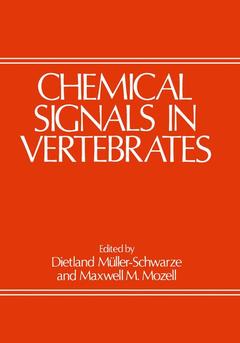Description
Chemical Signals in Vertebrates, Softcover reprint of the original 1st ed. 1977
Coordinator: Muller-Schwarze Dietland
Language: English
Keywords
Mammalia; adaptation; amphibians; anatomy; animals; ecology; fish; insects; mammals; reproduction; reptiles; social behavior; system; vertebrates; wildlife management
Publication date: 03-2012
610 p. · 17.8x25.4 cm · Paperback
610 p. · 17.8x25.4 cm · Paperback
Description
/li>Contents
/li>
From June 6 to 9, 1976, about 140 participants (physiologists, chemists, ecologists, animal behaviorists, and psychologists) gathered in the Gideon Putnam Hotel at Saratoga Springs, New York for a symposium entitled "Chemical Signals in Vertebrates". The focus of this symposium, sponsored by the United States National Science Foundation, was on chemical communication in higher animals, most notably mammals. This included the chemical nature, production, and reception of chemical signals, and their modulating effects on behavior. Almost all the world's laboratories working in this area were represented. It was the first meeting of its kind, and although the physiological aspects of taste and smell on the one hand and insect pheromones on the other have previously been treated in several fine symposia, they have not before been treated as a back drop to chemical communication in vertebrates. The field of insect pheromones is well developed, with hundreds of active compounds identified. By contrast, in vertebrates only six mammalian phero mones in as many species had been identified chemically by 1976.
One: Sources of Chemical Signals.- Structure and Function of Skin Glands.- Hormonal Control of Mammalian Skin Glands.- Bacteria as a Source of Chemical Signals in Mammals.- Chemical Attractants of the Rat Preputial Gland.- Two: Chemistry.- Properties of Compounds Used as Chemical Signals.- Chemical Methodology in the Study of Mammalian Communication.- Chemical and Behavioral Complexity in Mammalian Chemical Communication Systems: Guinea Pigs (Cavia porcellus), Marmosets (Saguinus fuscicollis) and Humans (Homo sapiens).- On the Chemical and Environmental Modulation of Pheromone Release from Vertebrate Scent Marks.- Three: Behavior:Reviews.- Chemical Communication in Amphibians and Reptiles.- Chemical Signals in Agonistic and Social Behavior of Rodents.- Pheromonal Influences on Rodent Agonistic Behavior.- Olfaction in Relation to Reproduction in Domestic Animals.- Four: Behavior:Laboratory Studies.- Sex Pheromones in Golden Hamsters.- Chemical Signals and Primate Behavior.- A Review of Recent Psychophysical Studies Examining the Possibility of Chemical Communication of Sex and Reproductive State in Humans.- Physical and Cognitive Limitations on Olfactory Processing in Human Beings.- Five: Ecology.- Chemical Communication as Adaptation:Alarm Substance of Fish.- The Study of Chemical Communication in Free-Ranging Mammals.- Two Hypotheses Supporting the Social Function of Odorous Secretions of Some Old World Rodents.- The Search for Applications of Chemical Signals in Wildlife Management.- Six: Bioassay.- From Insect to Mammal: Complications of the Bioassay.- Methodology and Strategies in the Laboratory.- Complex Mammalian Behavior and Pheromone Bioassay in the Field.- Seven: Reception of Chemical Signals.- Functional Anatomy of the Mammalian Chemoreceptor System.- Minimum Odorant Concentrations Detectable by the Dog and Their Implications for Olfactory Receptor Sensitivity.- Processing of Olfactory Stimuli at Peripheral Levels.- Taste Stimuli as Possible Messengers.- Eight: Central Processes.- Central Processing of Olfactory Signals.- Dynamic Aspects of Central Olfactory Processing.- On the Anatomical Substrate for Flavor.- Central Processing of Odor Signals: Lessons from Adult and Neonatal Olfactory Tract Lesions.- Central Control of Scent Marking.- Author Index.
© 2024 LAVOISIER S.A.S.




